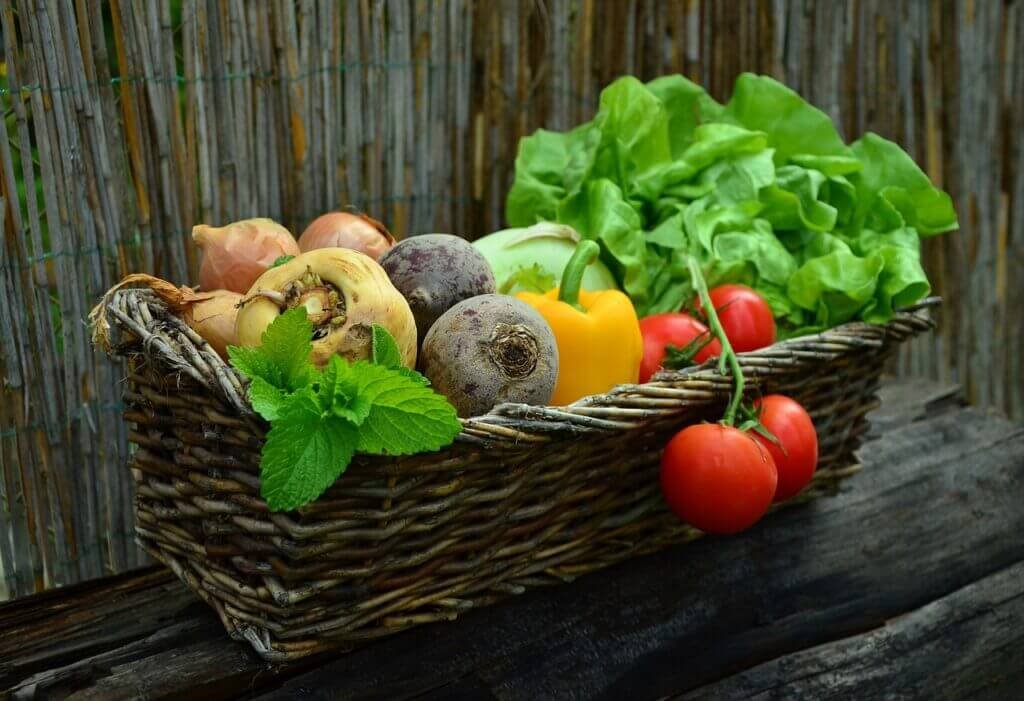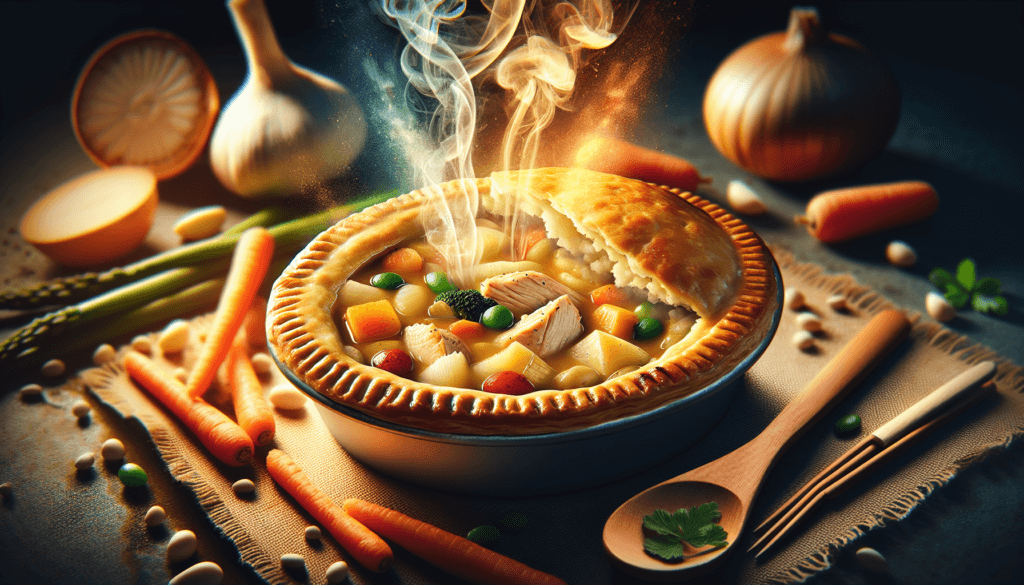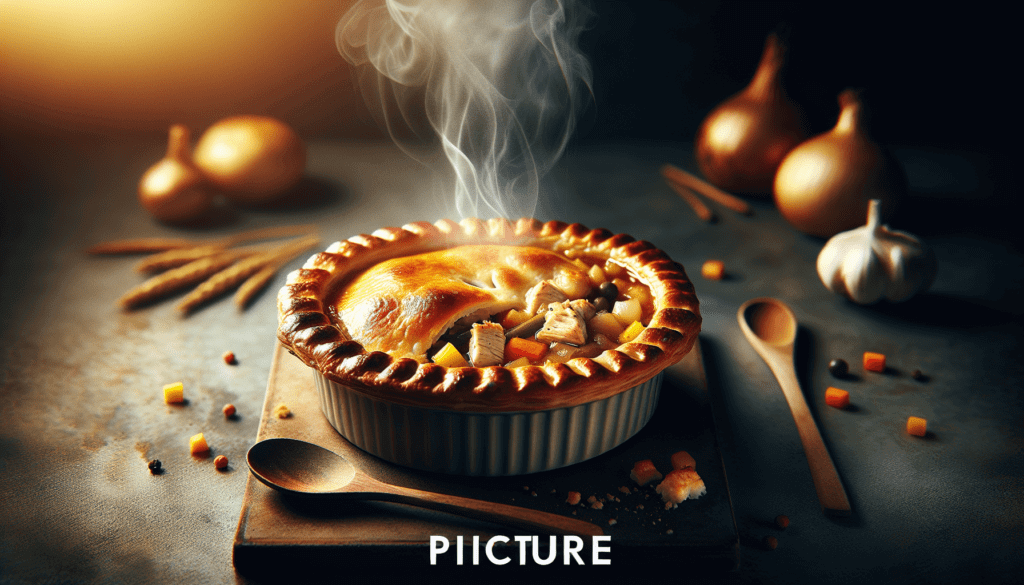So you’ve decided to try your hand at making a delicious chicken pot pie, but you’re not quite sure where to begin. Fear not, because this beginner’s guide is here to help you every step of the way. From selecting the perfect ingredients to mastering the art of flaky crust, this article will provide you with all the information you need to create a mouthwatering chicken pot pie that will impress even the most discerning taste buds. Whether you’re a seasoned chef looking to try something new or a kitchen novice ready to embark on a culinary adventure, this guide will ensure that your chicken pot pie turns out perfectly every time. So grab your apron and let’s get started on this delectable journey together!

Ingredients
Pie Crust
The first step in making a delicious chicken pot pie is preparing the pie crust. You have two options when it comes to the crust – you can either use a store-bought pie crust or make your own homemade version. Store-bought pie crusts offer convenience and save you time in the kitchen, while homemade crusts allow you to add your personal touch to the dish.
Filling
The filling is the heart of the chicken pot pie. To make a flavorful and hearty filling, you will need cooked chicken as the main protein. You can either cook your own chicken or use leftover cooked chicken for this recipe. Along with the chicken, sautéed vegetables such as carrots, peas, and onions add texture and flavor to the filling.
Seasonings and Spices
To elevate the flavors of your chicken pot pie, don’t forget to add seasonings and spices. Common seasonings for this dish include salt, pepper, thyme, and garlic powder. Feel free to experiment with different herbs and spices to suit your taste preferences.
Equipment
To successfully make a chicken pot pie, you will need a few essential tools in your kitchen.
Pie Plate or Baking Dish
A pie plate or baking dish is where you will bake your chicken pot pie. Make sure you choose a deep dish that can accommodate the filling and the crust.
Rolling Pin
A rolling pin is essential for rolling out the pie crust to the desired thickness. If you don’t have a rolling pin, you can also use a sturdy glass bottle.
Mixing Bowl
A mixing bowl is where you will combine all the ingredients for the filling. Look for a bowl that is large enough to hold the chicken, vegetables, and sauce.
Whisk
A whisk comes in handy when making the sauce for the filling. It helps ensure that all the ingredients are well combined and there are no lumps.
Cutting Board
A cutting board is necessary for chopping the vegetables and preparing the chicken. Make sure you have a clean and sturdy cutting board that provides ample space for your ingredients.
Knife
A sharp knife is essential for cutting the vegetables and preparing the chicken. Choose a knife that feels comfortable in your hand and allows you to chop with precision.
Preparing the Pie Crust
Store-bought Pie Crust
If you opt for a store-bought pie crust, the preparation process is incredibly easy. Simply follow the instructions on the packaging to prepare the crust for your chicken pot pie. Most store-bought crusts come in a pre-rolled form, so all you have to do is unroll it and place it in your pie plate or baking dish.
Homemade Pie Crust
Making your own homemade pie crust may sound intimidating, but it’s actually quite simple. To make a basic pie crust, you will need all-purpose flour, chilled butter, ice water, and a pinch of salt. Combine the flour and salt in a mixing bowl, then cut the chilled butter into small pieces and add it to the flour mixture. Use a pastry cutter or your hands to incorporate the butter until the mixture resembles coarse crumbs. Gradually add the ice water and mix until the dough comes together. Shape the dough into a disk, wrap it in plastic wrap, and refrigerate it for at least 30 minutes before rolling it out.
Preparing the Filling
Cooking the Chicken
If you’re starting with raw chicken, you’ll need to cook it before adding it to the filling. You can either bake, boil, or sauté the chicken breasts until they are fully cooked and no longer pink in the center. Once the chicken is cooked, allow it to cool slightly before shredding or dicing it into bite-sized pieces.
Sauteing the Vegetables
To ensure a flavorful filling, sauté the vegetables in a little bit of oil or butter until they are tender. Start by sautéing onions until they turn translucent, then add carrots and cook them until they start to soften. Finally, add peas to the mix and cook for a few more minutes until all the vegetables are cooked to your liking.
Making the Sauce
The sauce is what brings all the ingredients together in the filling. In a separate saucepan, melt butter over medium heat and whisk in flour to create a roux. Gradually add chicken broth and milk to the roux while whisking continuously until the mixture thickens. Season the sauce with salt, pepper, and any additional herbs or spices you desire. Let the sauce simmer for a few minutes before combining it with the cooked chicken and sautéed vegetables.

Assembling the Pie
Rolling Out the Pie Crust
If you’re using a homemade pie crust, take it out of the refrigerator and allow it to soften slightly before rolling it out. On a floured surface, use a rolling pin to roll the dough into a circle that is slightly larger than your pie plate or baking dish. Roll the dough gently, starting from the center and moving outward, rotating it occasionally to maintain an even thickness.
Lining the Pie Plate
Once your crust is rolled out, carefully transfer it to your pie plate or baking dish. Gently press the crust into the plate, making sure it adheres to the sides and the bottom. Trim any excess crust hanging over the edges with a knife or kitchen shears.
Adding the Filling
Pour the prepared filling into the lined pie plate, spreading it evenly. Make sure to leave a little room at the top for the crust.
Covering the Pie
Roll out another piece of pie crust to create the top crust. Carefully place it over the filling, pressing down the edges to seal it with the bottom crust. Trim any excess crust, leaving about half an inch overhang.
Crimping the Edges
To create a decorative edge for your pie, use your fingers or a fork to crimp the edges. Press the tines of the fork or your fingers into the overhanging crust, creating a pattern around the edges of the pie.
Baking the Pie
Preheating the Oven
Before baking your chicken pot pie, preheat the oven to the recommended temperature. Most recipes call for a preheated oven set to around 375°F (190°C).
Egg Wash
For a golden and glossy crust, brush the top of the pie with an egg wash. Beat one egg with a tablespoon of water and use a pastry brush to lightly coat the crust.
Venting the Pie
To allow steam to escape during baking, create vents in the top crust. This can be done by using a sharp knife to make small slits or by cutting out decorative shapes with a small cookie cutter.
Baking Time and Temperature
Place the assembled pie on a baking sheet to catch any potential spills, then transfer it to the preheated oven. Bake the chicken pot pie for about 30-40 minutes or until the crust is golden brown and the filling is bubbling. Keep an eye on the pie, as baking times may vary depending on your oven.

Tips and Variations
Using Different Proteins
While chicken is the traditional protein for a chicken pot pie, you can easily switch it up by using other meats or even tofu for a vegetarian version. Turkey, ham, or even shrimp can be great alternatives for a different flavor experience.
Adding Herbs and Spices
To enhance the taste of your chicken pot pie, experiment with different herbs and spices. Fresh herbs like rosemary, thyme, or sage can add a burst of flavor. You can also spice things up with a pinch of cayenne pepper or paprika for some heat.
Adding Vegetables
While carrots, peas, and onions are classic vegetables for a pot pie, feel free to get creative and add your favorite vegetables. Corn, mushrooms, broccoli, or bell peppers can all be fantastic additions to the filling.
Making Mini Pot Pies
If you prefer individual servings or want to impress your guests, you can make mini pot pies instead of one large pie. Simply divide the filling and crust into individual portions and follow the same assembly and baking instructions.
Gluten-free or Vegan Options
For those with dietary restrictions, you can still enjoy a delicious chicken pot pie. Look for gluten-free crust recipes or pre-made gluten-free crusts at your local grocery store. To make a vegan version, substitute plant-based proteins like tofu or chickpeas for the chicken and use a dairy-free butter and milk alternative for the sauce.
Freezing and Reheating
Chicken pot pie freezes remarkably well, making it a great option for meal prep or leftovers. After baking, allow the pie to cool completely, then wrap it tightly in plastic wrap and aluminum foil before placing it in the freezer. When ready to enjoy, simply thaw the pie in the refrigerator overnight and reheat it in the oven until heated through.
Serving and Enjoying
Cooling and Resting the Pie
Once your chicken pot pie is done baking, resist the urge to dig in right away. Allow the pie to cool for at least 10 minutes to give the filling and sauce time to set. This also helps prevent any potential burns from the hot filling.
Serving Sizes
The serving size of a chicken pot pie can vary depending on individual appetites and portion preferences. A standard pie usually serves about 6-8 people. However, you can adjust the serving size by making mini pot pies or doubling the recipe to feed a larger crowd.
Serving Suggestions
Chicken pot pie is a complete meal in itself, but you can enhance the experience by serving it with a side salad or steamed vegetables. Additionally, a dollop of sour cream or a sprinkle of grated cheese on top of the pie can take it to the next level.

Troubleshooting
Soggy Crust
If your crust is turning out soggy, try pre-baking the bottom crust for a few minutes before adding the filling. This helps create a barrier and prevents the crust from becoming overly moist.
Runny Filling
To avoid a runny filling, make sure you allow the cooked vegetables and sauce to cool slightly before assembling the pie. The filling will thicken as it cools down, ensuring a perfect consistency.
Undercooked Crust
If your crust is undercooked and pale, try increasing the baking time or temperature. You can also cover the edges of the crust with foil to prevent them from burning while the center continues to cook.
Overcooked Filling
To prevent overcooked filling, make sure you dice or shred the chicken into evenly sized pieces. This ensures that all the chicken cooks at the same rate and prevents drying out.
Burnt Edges
If you find that the edges of your pie are getting too dark while baking, cover them with foil to prevent further browning. This will ensure a nicely cooked crust without any burnt edges.
Conclusion
Making a homemade chicken pot pie may seem like a daunting task at first, but with the right ingredients, equipment, and guidance, it can be a fun and rewarding culinary adventure. From preparing the pie crust and filling to assembling and baking the pie, each step contributes to the creation of a delicious, comforting dish. So, roll up your sleeves, gather your ingredients, and get ready to impress your friends and family with your homemade chicken pot pie skills. Remember, practice makes perfect, so don’t be discouraged if your first attempt isn’t picture-perfect. Enjoy the process and savor the delicious results!



